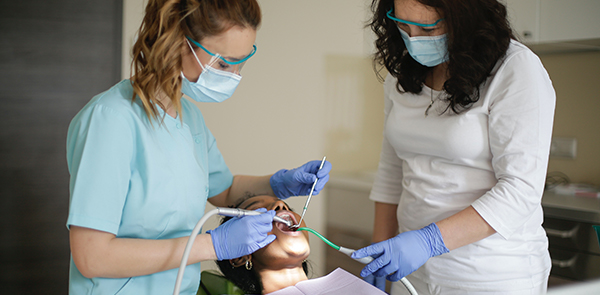Dental practices in states like Florida and Virginia are slowly but surely reopening, providing a glimpse into the not-so-distant future when offices across the county emerge from the broad closures due to the COVID-19 pandemic and resume patient care.
Heavily impacted by COVID-19, 84% of dentists said practice volume was less than 5% compared to what is typical, according to an ADA Health Policy Institute survey conducted last month.
With stats like that and mounting bills, dentists are eager to get back to work.
“We have a pretty optimistic outlook on things,” Dr. Michael May told boston.com. “We think that once we open the doors back up, we get into a routine again, and then we kind of establish an environment that patients feel safe in, that we’ll slowly pick back up.”
As business resumes, dental practices will be adopting to a new normal. Follow these five steps for a successful reopening.
1. Communicate With PatientsCommunication is key to helping patients feel comfortable, safe, and reassured about returning for care. In particular, you should communicate your infection control standards and set expectations for when patients return. In a recently released toolkit, the ADA suggests sharing with patients that they should expect screening questions, different waiting room procedures, and social distancing guidelines.
2. Engage With Your Dental TeamWith a risk score of 99.7, dental hygienists rank among the highest risk occupations for COVID-19. Naturally, many hygienists have fears about returning to the workforce.
The aerosols that are created in dental offices are not safe for anybody working there or coming into the office, if you have patients that have COVID-19 and they don't even know it, Janet Costick, a retired hygienist, told weartv.com. Another concern, she said, is proper personal protective equipment (PPE).
ADA President, Dr Chad P. Gehani, acknowledges these concerns and highlights the importance of open communication to address them.
“Team members must feel comfortable that sensible precautions are being taken in the dental office, and they must be comfortable explaining to patients what is being done on their behalf,” he said. “This crisis underscores how every member of the dental team is important and must be respected for their unique roles. Good communication is the key to making patients and the dental team comfortable as they return to our offices.”
3. Review Fee SchedulesDue to the implementing patient safety measures and providing additional PPE, dental practices will incur additional expenses. As the cost of care increases, the ADA recommends readjusting fee schedules and negotiating fee increases with third-party payers.
“While some payers may not be willing to negotiate, it is important to help them understand that just the cost of the additional personal protective equipment — not including any of the expenses related to additional safety precautions — may result in an added expense of about $15-$20 per patient visit,” said Dr. Randall Markarian, chair of the ADA Council on Dental Benefit Programs, in an ADA News article.
4. Screen For Eligibility ChangesWith the rise in unemployment, it’s likely that patients have changes in insurance plans. Make sure you screen patients to check their plans. According to Dr. Randall Markarian, chair of the ADA Council on Dental Benefit Programs, “… ask questions when patients come in so that you don’t potentially increase your financial hardship. If the patient has a new plan, make sure you receive the summary of benefits and understand what services are covered because plan designs are always different.”
5. Consider Teledentisty
Dentists are breaking into the new frontier of teledentistry amid the COVID-19 pandemic. From triaging emergency patients to preventing interruptions in orthodontic treatment, teledentistry is proving beneficial both now and into the future.
Nestor Villarreal, DDS, of Bellaire Bay Dental Care in Naples, Florida, believes teledentistry represents the next phase of oral healthcare and has a tremendous potential to improve dental treatments in the future.
"With my current concerns of keeping patients and their families safe during the COVID-19 pandemic, teledentistry enables me to provide safe consultations and dental care to those who otherwise might have to wait for treatment. Reassuring patients with live video allows me to evaluate emergencies and provide care instructions," he said. "As I look to the future, I believe teledentistry will help dental professionals build healthier communities by expanding the reach and capabilities of traditional dental practices."


